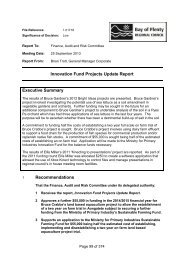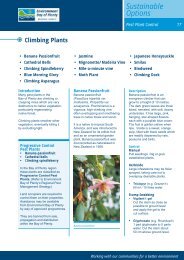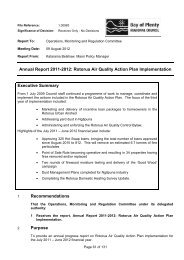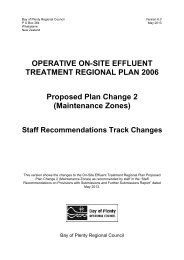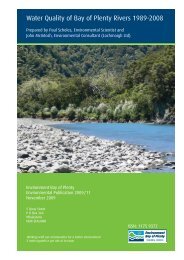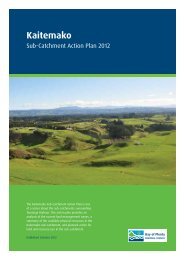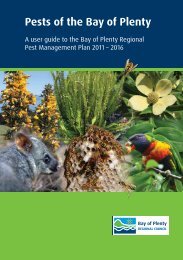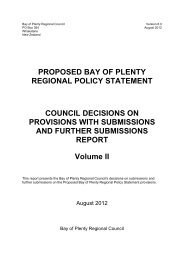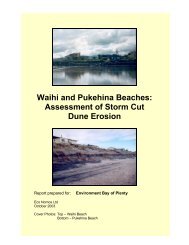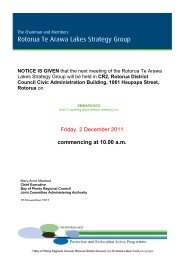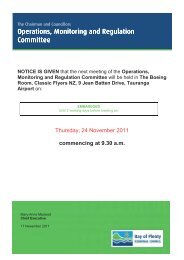Odour Threshold Investigation 2012 - Bay of Plenty Regional Council
Odour Threshold Investigation 2012 - Bay of Plenty Regional Council
Odour Threshold Investigation 2012 - Bay of Plenty Regional Council
You also want an ePaper? Increase the reach of your titles
YUMPU automatically turns print PDFs into web optimized ePapers that Google loves.
Kevern 56 undertook several surveys (20/8/93, 10/9/93 and 17/9/93) using a Jerome<br />
Model 621 sensor with a H 2 S detection range <strong>of</strong> 0-50 ppb. Measurement points<br />
were at irregular intervals along the State Highway from Kawerau to Rotorua.<br />
Results showed that the H 2 S level around Rotoehu/Rotoma were below 5 ppb.<br />
Kevern noted that samples taken at the Waitangi Soda Springs on 10 September<br />
were high (up to 45 ppb) compared to the values recorded on 17 September and<br />
attributed this to possibly a contamination <strong>of</strong> the measurement cell from high<br />
readings recorded in Rotorua earlier in the day. Elevated levels were found in the<br />
Kawerau, Tikitere and Rotorua areas (15->50 ppb).<br />
4.2.4 Tauranga Harbour<br />
Monitoring <strong>of</strong> ambient H 2 S associated with decomposing sea lettuce 57 has shown<br />
concentrations that are at adverse human health effect levels. Two sites in<br />
Tauranga Harbour, Ongare Point and Ngakautuakina Point, were selected for<br />
monitoring <strong>of</strong> H 2 S based on reported odour issues and health concerns raised by<br />
local residents. When the material was disturbed, both sites recorded values greater<br />
than ~288,000 μg/m 3 . Values recorded ~1 m above the surface ranged from 2.88<br />
mg/m 3 to 14.4 mg/m 3 .<br />
A summary <strong>of</strong> the ambient values from this section are shown in Table 4.1. For the<br />
purposes <strong>of</strong> comparison all H 2 S volume measurements have been converted to<br />
weight-based measurements (see Section 1). It should be noted that the results<br />
obtained by different measurement methods may not be directly comparable<br />
(sampling inlet position has been noted where known). No allowance has been<br />
made for the different measurement sampling and averaging times.<br />
The summary table shows that a wide range <strong>of</strong> concentrations can be experienced<br />
depending on location. Also at any given location there can be variations <strong>of</strong> several<br />
orders <strong>of</strong> magnitude in the values monitored, most likely due to variations in<br />
emissions and/or meteorological conditions.<br />
56 Kevern, R., 1993, BOPRC Internal memorandum, Ambient Hydrogen Sulphide Monitoring around<br />
Lake Rotoma, File Reference 1370 03 0077, 5p.<br />
57 BOPRC, 8 December 2009, Tauranga Harbour sea lettuce - hydrogen sulphide monitoring, Agenda<br />
Report to Regulation Monitoring & Operations Committee.<br />
18 Environmental Publication <strong>2012</strong>/06–A review <strong>of</strong> odour properties <strong>of</strong> H 2 S <strong>Odour</strong> <strong>Threshold</strong> <strong>Investigation</strong> <strong>2012</strong>



